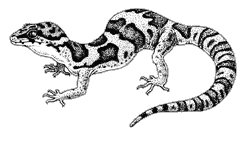Western Banded Gecko
(Coleonyx variegatus)
Order: Squamata
Family: Gekkonidae (gekkos)
Spanish name: salamanquesa de franjas
Distinguishing Features
This delicate-looking lizard seldom exceeds 3 inches in length, excluding the tail. It has moveable eyelids and large eyes with vertical pupils. The small body scales are granular and soft; the toes are slender. There is a constriction at the base of the otherwise bulky tail. The tail is about as long as the body with indistinct rings. Between the pairs of legs are dark brown crossbars on a pale yellow, pink, tan, or cream background. The eyelids are edged in white. The head and body are mottled with light brown. The belly is somewhat translucent. Males have prominent spurs on either side of the body at the base of the tail.

Range
The western banded gecko occurs in the Mohave and Sonoran deserts.
Habitat
The western banded gecko is found in open arid deserts and desert grassland, in canyons and on hillsides. It is usually associated with rocks or other shelters, but is also is found in sandy arroyos and dunes.
Life History
Active principally at night, western banded geckos can be seen crossing roads during the summer. It has been suggested that their gait and carriage mimics that of the scorpions of the genus Hadrurus that share the same habitat. If disturbed, the gecko will wave its tail to divert attention of a would-be predator away from its head and body. The tail has specialized fracture planes that allow it to easily break off. Blood vessels close off rapidly to prevent much blood loss and the writhing tail is left behind. This may allow the lizard to escape predation; its tail is very rapidly regrown. However, the regenerated tail consists of cartilaginous material that lacks fracture planes; it is also shorter than the original and has different color patterns and scales.
The tail of the gecko serves as more than a way of escaping predation. It also stores food and water that the animal uses during lean times, including winter dormancy. Regrowing the tail is energetically expensive and the loss of the tail can put the survival of the lizard in jeopardy—especially if it was lost just before the onset of winter.
Banded geckos feed on a variety of invertebrates including beetles, spiders, grasshoppers, sowbugs, termites, and solpugids. Two eggs are laid in late spring, with females laying 2 clutches a year. After 6 weeks, the eggs hatch into 1 inch (2.5 cm) long lizards.
Comment
This small lizard is often mistaken for a young Gila monster due to the similarity of the pattern. A banded gecko can be distinguished from a Gila monster by its small size (young Gila monsters are around 6 inches; 15 cm) and the lack of bead-like scales on the back. Banded geckos may emit a squeak when captured.